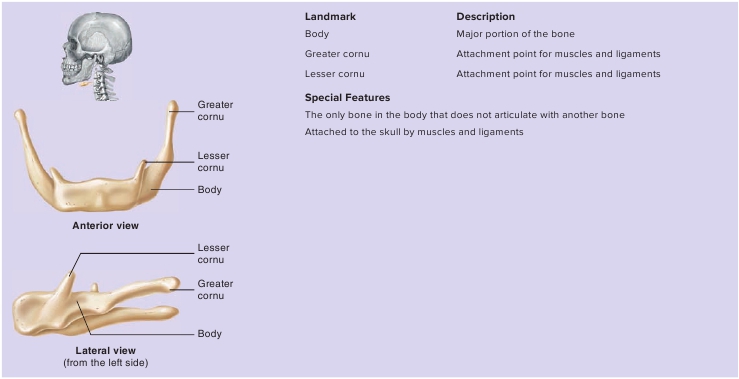CHAPTER 7 Skeletal System: Gross Anatomy
215
TABLE
7.8
Hyoid Bone—Anterior and Lateral Views

The hyoid bone provides an attachment point for some tonguemuscles and for important neck muscles that elevate the larynxduring speech or swallowing.
Vertebral Column
The
vertebral column
performs five major functions: (1) It supportsthe weight of the head and trunk, (2) it protects the spinal cord,(3) it allows spinal nerves to exit the spinal cord, (4) it providesa site for muscle attachment, and (5) it permits movement of thehead and trunk.The vertebral column usually consists of 26 bones, called
vertebrae,
which can be divided into five regions: 7
cervicalvertebrae
(ver′t ĕ -br ē ), 12
thoracic vertebrae,
5
lumbarvertebrae,
1
sacral bone,
and 1
coccygeal
(kok-sij′ ē - ă l)
bone
(figure 7.13). To remember how many vertebrae are in eachregion, think of mealtimes: 7, 12, and 5. The cervical vertebrae aredesignated “C,” thoracic “T,” and lumbar “L.” A number after theletter indicates the number of the vertebra, from superior to infe-rior, within each vertebral region. For example, “C1” refers to thefirst cervical vertebra. The developing embryo has about 33 or 34vertebrae, but by adulthood the 5 sacral vertebrae have fused toform 1 bone, and the 4 or 5 coccygeal bones usually have fused toform 1 bone.The adult vertebral column has four major curvatures(figure 7.13). Two of the curves appear during embryonic devel-opment and reflect the C-shaped curve of the embryo and fetus
within the uterus. When the infant raises its head in the first fewmonths after birth, a secondary curve, which is convex anteriorly,develops in the neck. Later, when the infant learns to sit and thenwalk, the lumbar portion of the column also becomes convex ante-riorly. Thus, in the adult vertebral column, the cervical region isconvex anteriorly, the thoracic region is concave anteriorly, thelumbar region is convex anteriorly, and the sacral and coccygealregions together are concave anteriorly. These spinal curvatureshelp accommodate our upright posture by aligning our bodyweight with our pelvis and lower limbs.
General Features of the Vertebrae
The general structure of an individual vertebra is outlined intable 7.9. Each vertebra consists of a body, vertebral arch,and various processes. Two of the vertebral column’s majorfunctions—to help support the body’s weight and to protect thespinal cord—are achieved by two specific portions of the verte-brae. The weight-bearing portion of the vertebra is a solid, bonydisk called the
body.
The protection of the spinal cord is achievedby the body and the
vertebral arch,
which projects posteriorlyfrom the body.The vertebral arch is divided into left and right halves, andeach half has two parts: the
pedicle
(ped′i-kl; foot), which isattached to the body, and the
lamina
(lam′i-na; thin plate),which joins with the lamina from the opposite half of the arch.The vertebral arch and the posterior part of the body surround a